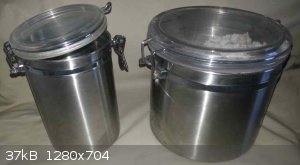RogueRose
International Hazard
    
Posts: 1594
Registered: 16-6-2014
Member Is Offline
|
|
Dessicant vessel from sealed stainless containers?
I have 2 SS cannisters that have a clear plastic lid with 2 layers of plastic forming the lid (there is a void in the middle) with a silicone gasket
seal. I was considering putting a hose barb through the lids and using these as a vacuum desiccant container and possibly a vacuum filtration
receiver (would need a second barb in the lid). I wouldn't be applying high vacuum to these so I don't see implosion as a risk. They are high quality
and when I squeeze the sides to try to crush it it doesn't deform at all, so it is fairly heavy gauge compared to some units.
As far as the liquids that would be filtered or evaporated I would stick with water - no solvents except maybe ethanol or methanol - so there
shouldn't be any issue with decomp of the lids.
I've never done drying in a desiccant container and thought I could do that as well, without vacuum. Placing anhydrous CaCl2 in the bottom of the
container and then put the cup/jar of whatever in the container and close the lid and seal the hose barbs (if I add them). Would this method of
drying work? I don't see how air circulates to get to the desiccant at the bottom, but from descriptions of other units, that seems to be how many
operate.

|
|
|
jack44556677
Harmless

Posts: 7
Registered: 20-1-2004
Member Is Offline
Mood: No Mood
|
|
Did you end up giving this a go? How'd it work out?
I wish I had more experience to speak of myself, but I AM working on that 
My understanding is that the porous nature of the desiccant (CaCl2) as well as physical space (filled by air, or out-gassed vapor if under vacuum)
between the pieces of the desiccant is what allows for the "airflow" required for the desiccant literally anywhere in the container to absorb moisture
out of the air. It is potentially imaginable that enough moisture might over-saturate just the top layer, let's say, causing it to melt completely (in
the case of CaCl2) and potentially cause an air tight seal of its own within the sealed container which is the only situation I can imagine which
might cause trouble... However I don't think that is really feasible unless you are splashing water onto the top layer exclusively, and you would know
it if it happened and be able to see it occur in your tanks (dry CaCl2 would stay at the bottom, and a hard rock crust only formed at the top of the
container at the boundary where the container air meets the desiccant). I doubt this will be much of a concern, and it should completely work (though
it will be slower than doing it with vacuum) and you may want to consider gently heating the containers to speed drying. The only thing I am
concerned about is contamination of the sample I'm drying with the desiccant.... CaCl2 is used to sterilize mammals.
As for the "robustness" of your vacuum containers, I say let a rip! I have found that 15 psi isn't really all that much, and especially when dealing
with small (quart and smaller) glass jars there hasn't been any issue taking them as far as I can to perfect vacuum. Conventional wisdom suggests to
do that with a rug / blanket over the bottle just in case it decides to implode. Larger steel containers should work, but deformation is definitely
possible depending on your steel thickness / shape / quality.
Have you had any experience desiccating with these, or other apparatuses, since this post? What have you used them for (if you don't mind sharing),
and if you used them for food; did the desiccant affect the taste? Also, I'm wondering if you'd comment on my other post, as I'm investigating the
best / most cost-effective way to freeze-dry things and you may be the perfect person to ask about it https://www.sciencemadness.org/whisper/viewthread.php?tid=71... ?
|
|
|
|